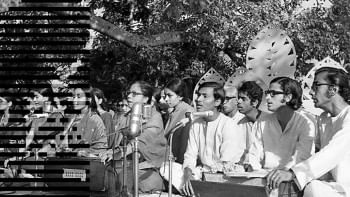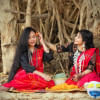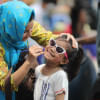A confluence of nature and culture

We are gradually becoming disconnected and displaced from a once-thriving agrarian world. A clear indication of this trend is our tendency to engage in needless debates over the rituals and festivals associated with year-end and new year celebrations. We constantly attempt to impose artificial binary divisions and authoritarian narratives upon the majority of the country's rural, subaltern population. To truly understand the festivities of the year's end and another beginning, we must understand the local ecosystems and seasonal cycles. It is essential to understand how rural communities establish their cultural relationships with the ecosystems across different seasons.
The relationship between the subaltern population and the living environment is deeply intricate. That is why, during year-end observances, some in the hills prepare Pazon (festive dishes), while those in the plains cook tita shak (bitter greens). Some mark the year's end with the blooming of Bhatjara flowers, others with the Bhat flower, some with the Nageshwar, and others with the emergence of Salleaves. These are the outcomes of a millennia-old, complex interaction between nature and culture. Such experiences cannot be hidden or erased by the fabricated binaries of Hindu versus Muslim. Exploitative and oppressive regimes often fear the influence of the rural subaltern culture. Throughout human history, the transitions, beginnings, and ends of seasons have been celebrated through rituals and festivals. These year-end and new year celebrations deliver a collective message about the protection of life and nature, and that message poses a serious threat to the ongoing neoliberal system.
Bhatiporob in Baishakh, Kormadi in Jaishtho-Ashar, Korondi in Shraban, Karam in Bhadro, Dasai in Ashwin, Jalabarta in Kartik, Wanna in Agrahayan, Pushra in Poush, Baghai Shirni in Magh, Ghatabandha in Phalgun, and Chaitporob or Chaitra Sankranti in Chaitra—each marks the seasonal transition with unique cultural expressions. In each season, nature signals its ending and beginning through various living forms. Communities organise rituals to seek permission and blessings for harvesting and using nature's new produce. During the months of Phalgun and Chaitra, nature blossoms with Bhath, Bhathjara or Biju flowers, Sal, Mahua, sweet pumpkin, Bilimbi, Venna, Amrul, Nageshwar, Palash, Kanthalichanpa, Dolanchanpa, and Konokchanpa. Fields and lands become filled with the spread of tita shak. Nature offers leaves, flowers, and fruits of all tastes—bitter, sour, sweet, salty, and spicy.
Across different regions of the country, year-end and new year celebrations are marked by festivals such as Chaitra Sankranti, Gajan, Del, Neel Puja, Charak, Halkhata, Noboborsho, and the Baishakhi fairs. Chakmas observe the Biju festival in three phases—Phulbiju, Mulbiju, and Gojjapojje. Tanchangyas, Pangals (Muslim Manipuris), and Bishnupriya Manipuris celebrate the Bishu festival. The Gurkhas and Assamese communities in Rangamati also observe the Bihu festival during this time; for the Koch people, too, the festival is known as Bihu. Many among the Hajong community celebrate the Hongorani festival. The Indigenous Bawm people celebrate Chapchar Kut festival. Around the same time, the Marmas observe Sangraing, the Tripuras celebrate Baisu or Baisuk, the Rakhines observe Sangrain, the Chaks also celebrate Sangraing, the Mros celebrate Changkran, and the Khiyangs mark the new year with their Sanglan festival. The Barman and Koch communities of Bhawal and Modhupur Garh celebrate Chaitra Sankranti through Sanyasi Puja, Gajan, and Charak Puja. Many Indigenous people in the tea gardens of Sylhet observe the Dondoborto festival during this period.

These year-end and new year festivals are generally held around the same time—at the end of Chaitra and the beginning of Baishakh. However, there is no such festival anywhere in the world called "Boi-Sa-Bi." This awkward and nationalistically motivated term was coined by combining the first Bangla letters from the names of three different festivals: Baisu, Sangraing, and Biju. For the matrilineal societies of the Mandi (Garo) and Khasi people, the timings of the year-end and new year celebrations are entirely different. According to the Mandi calendar, the last month of the year is Wachengza (February), and the first month is Galmakza (March). The Galmakdua festival is observed by the Mandis in March or April, although it is not a new year celebration. In the Khasi punji of Magurchhara, the Khasi year-end festival Seng Kutsnem is observed in the month of November. Among the Mros as well, year-end rituals such as Pratla Poi or Ningchchur Poi are held in certain places during the month of May.
Each season brings with it specific signs: nature's guidance. For thousands of years, the rural subaltern population has revered these instructions of nature, integrating them into the rhythm of life. From this reverence have evolved numerous rituals and festivals like those marking the year's end and beginning. The mass uprising of July-August 2024 raised a strong collective voice in favour of expanding this space for people's culture. The state must recognise this public aspiration and channel cultural reform and transformation into an inclusive and pluralistic framework.
The role of bitter greens
In both Bangalee and Indigenous communities, year-end rituals are incomplete without bitter greens and vegetables. Across different regions of the country, people consume 13 to 29 varieties of bitter-tasting greens such as Gima tita, Nailya, Gima, Dandokolosh, Amrul, Thankuni, Neem, Nishinda, Telakucha, Maloncho, Kanshira, Bashok, Ghrithikanchan, Shefali, Kolmi, Helencha, Ghum, Adabaron, Pipul, Gandhabhadali, Kantakhudi, and Khetpapra. In the hills, the Chakma community prepares Pazon, a dish made from bitter gourd, local aubergines, honagulo, wild potatoes, taro, bamboo shoots, and other indigenous vegetables. This mixed vegetable dish—made from as many as 30 to 107 ingredients—is called Kainbong in the Chakma language, Hang-Ro by the Marmas, and Moijarbong by the Tripura community.
The appeal of green mango
Around this time of the year, small mangoes ripen on the trees. It is customary to seek permission to eat the first mangoes of the season. Among the Rabidas community, the end of the year is observed with the hajra ritual. On this day, a mixture of roasted barley powder (chhatu) and green mango is prepared and consumed, known as aam-chhatuya. During Charak and Baishakhi pujas, green mangoes are often pierced onto iron tridents as part of the offerings. The Rabidas community also places their tools of shoemaking—shovels, scissors, knives, and chisels—at a sacred site known as Deokuri. During this time, traditional musical instruments such as dhak, dhol, khajri, and jhajhar are played.
And the trees and flowers…
The Santal calendar year begins in Phalgun, and the Baha festival is observed during this month. Around this time, flowers like Sarjam, Ichauk, Murup, and Mahua bloom across the trees. Through the Baha festival, the Santal community seeks blessings and permission to consume and use the nectar of these flowers. Before Baha, the social use of these blossoms was considered prohibited.
In the hills, the blooming of the Biju or Bhatjara flower signals the arrival of the Biju festival—also referred to by some as the Bei flower. During this time, the Biju bird can be heard calling at the hills. Children, adolescents, and women roam on the hills, in the forests and villages, gathering Bhatjara flowers. These wild blossoms are used to make garlands, exchange greetings, and decorate homes.
Kaikono or Nageshwar flowers are also natural markers of the year's end and beginning. During Sangraing, the Chakma people gather these flowers. On Paingshwet, or Flower Day, villages host traditional Chak games like peko (spinning tops), gyang (top toss), and maikanikcha (blindfold game). The second day of Sangraing is Akyai, when village youths play instruments like baik (drum), langhowak (cymbal), and hne (bamboo flute) and proceed together to the kyang (temple).
Pujas and fairs
One of the most widely recognised symbols of Chaitra Sankranti is the Gajan, Del, Neel, or Charak troupes that roam village to village. Dressed in red clothes and adorned as Shiva and Gauri—or sometimes masked—they collect alms. The Charak tree made from Sal wood and the Neel wood used in Neel Puja are iconic features of the celebration.
The traditional rural fairs held during Chaitra Sankranti and Pahela Baishakh also serve as grassroots cultural markers. In Gazipur, Moulvibazar, Habiganj, Sylhet, Tangail, Mymensingh, Netrokona, Natore, Pabna, Sirajganj, Chattogram, and various corners of the country, ancient fairs still survive. Records indicate that an ancient Biju fair was once held in Kadalpur, Chattogram, but it has disappeared over time.
People, not the state, are keepers of nature
We are gradually moving away from the intricate markers and symbols of nature. We are losing our connection to the transitions of the seasons and the historical language they embody. As a result, unnecessary debates are emerging around the year's end and beginning, dominated by self-serving elite narratives. The historical relationship between the rural subaltern, agricultural production, and Mother Nature is repeatedly being dismissed. Chaitra Sankranti or Pahela Baishakh marks the transition from one season to another. This moment of transition should be met with harmony and friendship—not with conflict or opposition. People have interpreted nature through various cultural symbols, and the state must ensure the preservation of those symbols.
Pavel Partha, an ecology and biodiversity conservation researcher, is director at Bangladesh Resource Centre for Indigenous Knowledge (BARCIK). He can be reached at [email protected].
Views expressed in this article are the author's own.
Follow The Daily Star Opinion on Facebook for the latest opinions, commentaries and analyses by experts and professionals. To contribute your article or letter to The Daily Star Opinion, see our guidelines for submission.

 For all latest news, follow The Daily Star's Google News channel.
For all latest news, follow The Daily Star's Google News channel. 









Comments